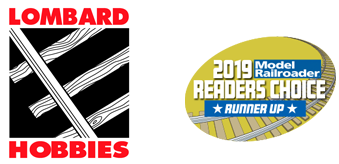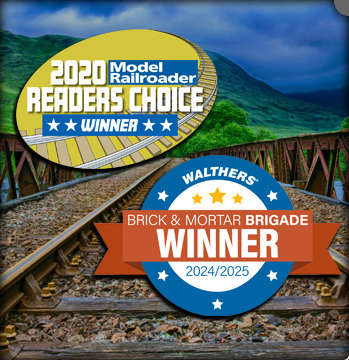ScaleTrains HO
ScaleTrains Rivet Counter HO SXT33695 Pullman-Standard 5820 Covered Hopper Data Only - Gray - Late Body Clerestory Roof
- In Stock:
- 3
- Scale:
- HO
- SKU:
- SXT33695
- Availability:
- Y
Description
ScaleTrains Rivet Counter HO SXT33695 Pullman-Standard 5820 Covered Hopper Data Only - Gray - Late Body Clerestory Roof
Road Number Specific ScaleTrains
- All-new model
- Era: 1978 to Early 2000s
- Fully-assembled
- Late body with clerestory stepped roof, and 19 unevenly-spaced side posts with bottom notches
- Centered end vents
- Photoetched stainless-steel, see-through Morton stamped round hole running boards with metal grab irons
- 'Mon-o-wheel' 24” roof hatches
- Photoetched stainless-steel, see-through Morton stamped round hole coupler crossover platforms
- Outlet bays with shaker brackets
- P-S / ITEL Corp. 'Micro-matic' pneumatic outlet gates
- Separately-applied ladders with metal rungs
- Separately-applied metal grab irons, coupler cut levers, and trainline hoses with silver gladhands
- Peacock Ellcon-National 33000 handbrake housing with detailed brakewheel and chain details
- Detailed brake system with separate air reservoir, control valve, and retainer valve details with separately-applied wireform plumbing
- Separately-applied trainline plumbing with mounting brackets mounted to inner sills of carbody
- Semi-scale coupler boxes with draft key detail
- Durable die-cast metal, semi-scale Type E couplers
- Highly-detailed Barber S-2 Buckeye Steel Castings Foundry 100-ton trucks with finely-rendered raised foundry data, separately-applied brake beams, and side bearing detail
- Brenco-6 rotating bearing caps
- 36” machined metal wheels with front and rear contour, .110" wide wheel tread, and tapered machined metal axles
- Operates on Code 70, 83 and 100 rail
- Printing and lettering legible even under magnification
- Weighted to Industry standards for reliable operation
- Packaging safely stores model
- Minimum radius: 18”
- Recommended radius: 22”
PROTOTYPE HISTORY:
Pullman-Standard was one of many legacy domestic car builders that would introduce a design intended to serve the plastics trade. Drawing heavily upon existing grain hopper designs in their catalog, Pullman-Standard introduced a 5820cf capacity car in late 1971. Designed with plastics products in mind, these exterior-post cars were imposing, featuring four bays, and a length of nearly 70 feet over the couplers. The earliest versions featured a peaked roofline and 17 exterior posts per side.
Later versions adopted the trademark P-S 'clerestory' roofline that was also utilized on their landmark 4750cf grain hopper, as well as a revised side panel construction utilizing 19 posts. Initially, the posts featured a small triangular notch at the bottom before switching back to a solid-bottom design. Also reflecting a family appearance with other designs in the P-S catalog, such as the 4785cf covered hopper, all of the 5820cf cars featured vertical structural shear plates on the end sills.
The P-S 5820cf covered hopper proved to be a popular design, with a large number built for a number of private owners, as well as Pullman-Standard’s lease fleet, between 1971 and 1982. While the oldest 5820 cars have been withdrawn from interchange service by now, having reached their 40-year age limit, cars built after July 1st, 1974 are allowed 50 years of service, and up to 65 years if they meet 'Increased Service Life' criteria. And like most car designs, the 5820s have exhibited changes over their service lives, mostly to their hatches and outlets.
As-built, most were equipped with P-S / ITEL Corp. proprietary 'Micro-Matic' pneumatic outlets and either 'Mon-o-Wheel' or 'Tri-Wheel' roof hatches. As these components wore out, they would often be replaced by aftermarket replacements, such as Salco-brand Kam-Op pneumatic outlets. Salco also offers a popular line of replacement hatches for these cars, either plain or vented, which helps negate the need for personnel to climb onto the car running boards to open hatches for venting while unloading.
Operationally, they tended to congregate in petrochemical production regions waiting for loading e.g., the Texas 'Chemical Coast', but were – and still are – seen traveling nationwide in singles or in blocks of cars heading to production facilities for items ranging from plastic milk jugs to fiberglass panels. Interestingly, they can also be seen staged at plastics logistics yards where huge blocks of loaded plastics hoppers are parked, with pellets bought and unloaded as needed onsite by the customer using tractor-pneumatic tank trailer rigs, essentially making the cars rolling warehouses.
Lombard Hobbies - Your #1 Largest Authorized ScaleTrains Select Retailer!

























